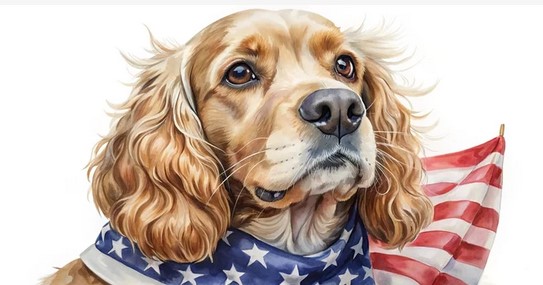Spaniels are a group of dog breeds historically known for their skill in hunting and retrieving, particularly for game birds. The term “spaniel” itself is believed to have originated from the word “Spanish,” as the breed was initially associated with Spain, though it is now found in many parts of the world. The spaniel breed has a long and storied history, dating back to ancient times. The earliest records of spaniels appear in the 14th century, but their origins likely go back even further. Early spaniels were highly valued for their work as hunting companions, particularly in retrieving game from water, and were often used by nobility and hunters for these purposes.

Over the centuries, spaniels have been refined into various types, each designed for specific tasks. Today, there are numerous types of spaniels, with some of the most well-known being the Cocker Spaniel, Cavalier King Charles Spaniel, English Springer Spaniel, American Water Spaniel, and the Clumber Spaniel. These breeds, although sharing a common ancestry, vary in size, coat type, and temperament, and have been developed to suit different environments and types of hunting. For example, the Cocker Spaniel is known for its smaller size and agility, making it ideal for flushing game from dense underbrush, while the English Springer Spaniel is a larger, highly energetic breed used for flushing and retrieving in more open spaces.
Spaniels are beloved by many pet owners for a variety of reasons. One of the primary appeals of the spaniel breed is their affectionate and friendly nature. Spaniels are generally very sociable dogs that form strong bonds with their families and are known for being excellent companions. Their intelligence and eagerness to please also make them highly trainable, which is another reason they are popular as pets. In addition, their playful and gentle demeanor makes them great with children and other pets, which is important for families.
Another key factor in their popularity is their versatility. Spaniels can be active and enjoy exercise, but they are also content with quieter, more relaxed times at home. This balance makes them a suitable pet for a variety of living situations, whether in a larger home with a yard or in a smaller apartment. Furthermore, their compact size and relatively low-maintenance coats (depending on the breed) make them manageable for many dog owners.
Ultimately, spaniels’ charming personality, trainability, and ability to adapt to various lifestyles make them a beloved choice for dog lovers worldwide.
Blog Service Spaniels
Service dogs play a crucial role in supporting individuals with a variety of physical and mental health challenges. These specially trained dogs are more than just companions; they are vital to the wellbeing and independence of their owners. As someone who studied human behavior in university, I’ve come to realize just how unique the bond between a service dog and their handler is and how it differs from the relationship between a non-service dog and their owner. Specifically, I’ve often reflected on the distinct challenges of bringing a Spaniel—whether trained as a service dog or not—into public spaces like food stores. Though the natural warmth and intelligence of a Spaniel make them great companions, there are noticeable differences in the experiences depending on whether they are a service dog or not.
The first and most obvious difference between a service dog and a non-service dog is training. Service dogs undergo extensive training to help their owners with specific tasks. For example, a Spaniel trained as a service dog might assist someone with mobility issues by retrieving items, opening doors, or providing support while walking. For individuals with anxiety or PTSD, a service dog can offer grounding during episodes of panic. These tasks are learned through careful and deliberate training, often requiring months of work by specialized trainers. Non-service dogs, while often loving and loyal, lack this type of formal training. They may not have the skills or the temperament necessary to perform tasks that help mitigate a person’s disability.
This difference in training becomes evident when considering the challenges of taking a dog to a public space like a grocery store. If I were to bring a non-service dog, such as an untrained Spaniel, into a store, I’d likely face a series of difficulties. First, there’s the issue of behavior. Non-service dogs can be easily distracted by the smells of food or the movement of people, making it difficult for them to stay calm and focused. A well-behaved Spaniel might be calm in certain environments, but without the structure that comes with service dog training, there’s always the risk of barking, pulling on the leash, or even jumping on strangers. This behavior can create distractions in public places, potentially disrupting other shoppers and staff, as well as putting stress on the dog itself.
On the other hand, a Spaniel trained as a service dog is equipped to handle these situations with a calm demeanor. In the grocery store, the service dog knows how to remain by their handler’s side, ignore distractions, and follow specific commands. They understand that they are there to perform a job, not just accompany their owner. Their ability to stay calm and focused, even when surrounded by the chaos of a busy store, ensures they can still support their handler without causing disruptions. The handler can trust that the dog will remain in control and perform their duties, whether it’s carrying out a physical task or offering emotional support.
Another consideration when taking a non-service dog shopping is the issue of public access. Service dogs are granted legal rights under the Americans with Disabilities Act (ADA), which allows them to accompany their handlers in public spaces such as grocery stores, restaurants, and public transportation. Non-service dogs, however, do not have the same rights. If I were to bring a non-service Spaniel to a store, the store manager or staff would likely ask me to leave. Without the legal protection of being a service dog, a non-service dog is not allowed in most public spaces. This can lead to frustrating and embarrassing situations where I might have to find alternate ways of getting my dog to stay at home or in a pet-friendly area, even if I need to make quick errands.
Additionally, having a non-service Spaniel in a store can be stressful for both the handler and the dog. While many people love dogs and find their presence comforting, a busy public place can overwhelm a non-service dog. The noise, crowds, and unfamiliar smells can cause anxiety or agitation, which is difficult to manage without proper training. A trained service dog, by contrast, is accustomed to different environments and can act as an anchor for their handler, providing a sense of safety and security in places that might otherwise feel overwhelming.
There’s also the issue of the handler’s experience and expectations. As someone who has studied human behavior, I know how important it is for individuals with disabilities to feel empowered in managing their own lives. A service dog enhances that independence, giving the handler the confidence to participate in public activities that might otherwise be challenging. A non-service dog, no matter how well-meaning, doesn’t offer the same level of assistance and can inadvertently add stress to what should be a straightforward task, like grocery shopping.
The bond between a service dog and their handler is one of mutual trust and reliance. For individuals who rely on service dogs, these animals are not just pets; they are integral parts of their daily lives, offering both practical and emotional support. The difference between a Spaniel that is a service dog and one that is not is stark in terms of training, public access, and the overall shopping experience. While a non-service dog might be a beloved companion, only a service dog is prepared to seamlessly accompany their handler into public spaces without causing disruption or difficulty. This distinction highlights the importance of proper training and recognition of a dog’s role in supporting its owner, ensuring that both the human and the animal can navigate the world together with confidence and ease.
Why It’s Not Good to Allow Your Pet to Sleep on Your Bed
For many pet owners, letting their furry friend curl up next to them in bed feels comforting, loving, and emotionally satisfying. However, while the emotional bond between humans and their pets is undeniable, allowing pets to share your bed can bring a host of issues — some subtle, others more serious. Whether you’re a dog lover or a cat enthusiast, it’s worth considering why keeping your pet off your bed might actually be better for both of you.
1. Disrupted Sleep Patterns
One of the most common downsides to sleeping with your pet is the interruption of your sleep. Pets move around during the night — they may snore, scratch, twitch, or even walk across your bed. A pet’s restlessness can lead to repeated awakenings, ultimately reducing your sleep quality and preventing you from reaching deeper, restorative stages of sleep. Studies have shown that people who sleep with pets often experience more sleep disturbances and lower sleep efficiency.
Even if you don’t fully wake up, fragmented sleep can leave you feeling groggy, irritable, and less focused during the day. Over time, this can take a toll on your overall health, affecting your immune system, metabolism, and mental clarity.
2. Allergies and Hygiene Concerns
Pets naturally carry allergens such as dander, pollen, and dust on their fur. For people with allergies or asthma, sharing a bed with a pet can trigger symptoms like sneezing, itchy eyes, congestion, or wheezing. Even if you’re not allergic to animals themselves, exposure to the allergens they track in can make nights uncomfortable.
Beyond allergens, pets may bring dirt, bacteria, and even parasites like fleas or ticks into your bed. Outdoor animals especially can carry germs from other animals or waste. While regular grooming and vet checkups help reduce risk, no pet is completely germ-free. This introduces potential hygiene concerns, especially if you like to keep your bedding clean and fresh.
3. Behavioral Issues
Allowing your pet to sleep on your bed can sometimes lead to behavioral problems, especially in dogs. It can confuse their understanding of boundaries and hierarchy. For instance, some dogs may begin to display possessiveness over the bed, growling or guarding their sleeping area. Others might become more dependent, developing separation anxiety when they’re not allowed to sleep with you.
Training your pet to sleep in its own bed helps reinforce clear rules and boundaries. This consistency is important for obedience and maintaining healthy, respectful interactions between you and your pet.
4. Relationship Disruption
If you share your bed with a partner, your pet’s presence can interfere with your relationship. Whether it’s reduced physical intimacy, less personal space, or disrupted sleep for your significant other, having a pet in bed can create tension. While some couples enjoy sleeping with their pet together, it’s common for one partner to feel

